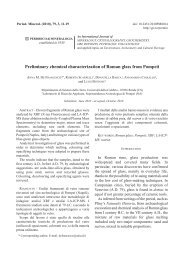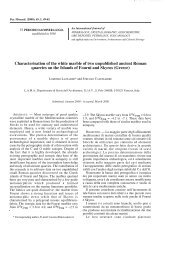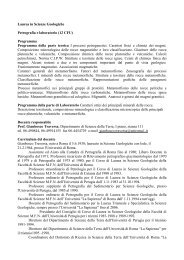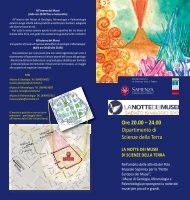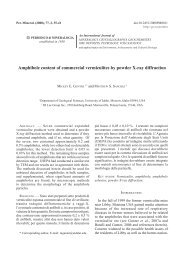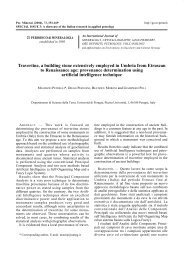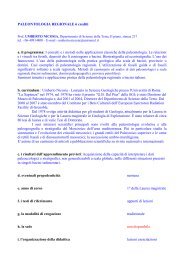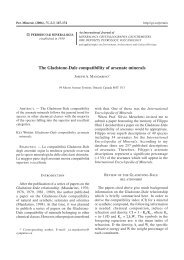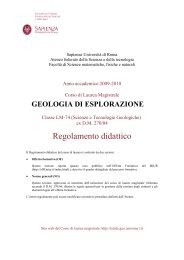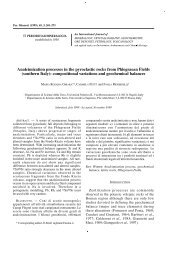Characterization and origin of alunite in the El-Gideda iron mine ...
Characterization and origin of alunite in the El-Gideda iron mine ...
Characterization and origin of alunite in the El-Gideda iron mine ...
Create successful ePaper yourself
Turn your PDF publications into a flip-book with our unique Google optimized e-Paper software.
Per. M<strong>in</strong>eral. (2007), 76, 1, 11-24http://go.to/perm<strong>in</strong>lPERIODICO di MINERALOGIAestablished <strong>in</strong> 1930An International Journal <strong>of</strong>MINERALOGY, CRYSTALLOGRAPHY, GEOCHEMISTRY,ORE DEPOSITS, PETROLOGY, VOLCANOLOGY<strong>and</strong> applied topics on Env<strong>iron</strong>ment, Archaeometry <strong>and</strong> Cultural Heritage<strong>Characterization</strong> <strong>and</strong> <strong>orig<strong>in</strong></strong> <strong>of</strong> <strong>alunite</strong><strong>in</strong> <strong>the</strong> <strong>El</strong>-<strong>Gideda</strong> <strong>iron</strong> m<strong>in</strong>e (Egypt)Mervat Hassan* <strong>and</strong> Hassan BaioumyCentral Metallurgical R & D Institute, P.O. Box 87, Helwan, Cairo, EgyptSubmitted, October 2006 - Accepted, December 2006* Correspond<strong>in</strong>g author, E-mail: mervathassan@hotmail.comAbstract. — Alunite <strong>in</strong> <strong>El</strong>-<strong>Gideda</strong> <strong>iron</strong> m<strong>in</strong>e,Bahria Oasis, occurs as very s<strong>of</strong>t <strong>and</strong> light white top<strong>in</strong>kish beds <strong>and</strong> pockets rang<strong>in</strong>g <strong>in</strong> thickness fromfew cm to 0.5 m <strong>in</strong>tercalated with glauconites <strong>of</strong> <strong>the</strong>Hamra Formation. The f<strong>in</strong>e scale m<strong>in</strong>eralogy wasdeterm<strong>in</strong>ed us<strong>in</strong>g XRD, SEM, DTA, TG, IR <strong>and</strong>XRF. Alunite is <strong>the</strong> ma<strong>in</strong> constituent, <strong>and</strong> jarosite wasdetected as a m<strong>in</strong>or m<strong>in</strong>eral. Hydrated halloysite is<strong>the</strong> ma<strong>in</strong> alum<strong>in</strong>um silicate m<strong>in</strong>eral associated with<strong>alunite</strong> <strong>in</strong> vary<strong>in</strong>g proportions. Gibbsite <strong>and</strong> trace <strong>of</strong>quartz are also detected. Iron oxides are representedby <strong>iron</strong>-oxyhydroxide (goethite) <strong>in</strong> size <strong>and</strong> shapesimilar to that <strong>of</strong> bacterial <strong>iron</strong> m<strong>in</strong>eralization.Amorphous silica was recorded <strong>in</strong> SEM image <strong>and</strong> IRspectra. Morphology <strong>of</strong> <strong>alunite</strong> ranged from tubular orflatten rhombohedral to well crystallized cubes. Thisis very characteristic for supergene <strong>alunite</strong> formed byoxidation <strong>of</strong> sulfides <strong>in</strong> a K-rich env<strong>iron</strong>ment. Due toacid alteration <strong>of</strong> sulfate, glauconites <strong>of</strong> <strong>the</strong> overly<strong>in</strong>gHamra Formation were altered <strong>and</strong> released K, Al, Si,<strong>and</strong> Fe. The former three elements form <strong>alunite</strong> <strong>and</strong>halloysite. Iron forms at least a part <strong>of</strong> <strong>the</strong> <strong>iron</strong> ore <strong>in</strong><strong>the</strong> <strong>El</strong>-<strong>Gideda</strong> m<strong>in</strong>e. Glauconite <strong>in</strong>tercalated by <strong>alunite</strong>is highly destabilized with fractured pellets <strong>and</strong> <strong>iron</strong>rims as well as low potassium content. Therefore,<strong>alunite</strong> <strong>and</strong> halloysite can be considered as byproducts<strong>of</strong> wea<strong>the</strong>r<strong>in</strong>g <strong>of</strong> <strong>the</strong> <strong>in</strong>tercalated glauconites<strong>in</strong> an env<strong>iron</strong>ment <strong>of</strong> sulfide oxidation (i.e., high Eh,low pH toge<strong>the</strong>r with biological activities).Riassunto. — L’<strong>alunite</strong> della m<strong>in</strong>iera di ferro di <strong>El</strong>-<strong>Gideda</strong>, nell’Oasi di Bahria, si r<strong>in</strong>viene <strong>in</strong> letti pococoerenti di colorazione variabile dal bianco chiaroal rosato o <strong>in</strong> tasche di spessore compreso tra pochicentimetri e mezzo metro; il m<strong>in</strong>erale è <strong>in</strong>tercalatoalla glauconite della Formazione di Hamra. Leanalisi di dettaglio riguardanti la m<strong>in</strong>eralogia sonostate eseguite tramite XRD, SEM, DTA, TG, IR eXRF. Assieme all’<strong>alunite</strong>, m<strong>in</strong>erale predom<strong>in</strong>ante, èstata identificata la presenza di jarosite. L’halloysiteidrata è il pr<strong>in</strong>cipale silicato di allum<strong>in</strong>io associatoall’<strong>alunite</strong> <strong>in</strong> varie proporzioni; sono stati ancheriscontrati gibbsite e tracce di quarzo. Gli ossidi diferro sono rappresentati da goethite con dimensionie forme analoghe a quelle delle m<strong>in</strong>eralizzazioni diferro di <strong>orig<strong>in</strong></strong>e batterica. Silice amorfa è stata rilevatatramite immag<strong>in</strong>i SEM e spettri IR. La morfologiadell’<strong>alunite</strong> varia da romboedri tubolari o appiattitia forme cubiche ben cristallizzate. Tali caratterisembrano tipici di aluniti supergeniche formate perossidazione di solfuri <strong>in</strong> ambienti ricchi di K. Aseguito della trasformazione dei solfati <strong>in</strong> ambienteacido, le sovrastanti glauconiti della Formazione
12 M. Hassan <strong>and</strong> H. Baioumydi Hamra hanno subito alterazioni con rilascio diK, Al, Si, e Fe. I primi tre elementi hanno formatol’<strong>alunite</strong> e l’halloysite mentre il ferro ha contribuitoalla formazione di almeno una parte degli adunamentidella m<strong>in</strong>iera di <strong>El</strong>-<strong>Gideda</strong>. La glauconite <strong>in</strong>tercalataall’<strong>alunite</strong> è <strong>in</strong> fase di avanzata destabilizzazioneessendo costituita da porzioni tipo pellets fratturati conbordi costituiti da ferro ed anche da discrete quantitàdi potassio. Pertanto, l’<strong>alunite</strong> e l’halloysite possonoessere considerate quali prodotti di trasformazione<strong>in</strong> ambiente meteorico delle <strong>orig<strong>in</strong></strong>arie glauconiti<strong>in</strong>tercalate <strong>in</strong> ambienti di ossidazione di solfuri ossiacon alto Eh, basso pH, unitamente ad attività di tipobiologico.Key words: Bahria Oasis, Egypt, gibbsite, <strong>alunite</strong>,glauconites, jarosite, wea<strong>the</strong>r<strong>in</strong>g.IntroductionAlunite is one <strong>of</strong> <strong>the</strong> m<strong>in</strong>erals <strong>of</strong> <strong>the</strong> <strong>alunite</strong>supergroup (see Jambor 1999, CanadianM<strong>in</strong>eralogist for recent classification). Its idealchemical formula is KAl 3(SO 4)2(OH) <strong>and</strong> itgenerally has rhombohedral or hexagonal habit.It is colourless <strong>in</strong> <strong>the</strong> pure state, but is found <strong>in</strong>grey-white, yellow-white <strong>and</strong> reddish colours dueto impurities <strong>in</strong> its structure. The <strong>alunite</strong> is formeddur<strong>in</strong>g alteration <strong>of</strong> alum<strong>in</strong>um- <strong>and</strong> potassiumbear<strong>in</strong>gmaterials such as clay m<strong>in</strong>erals <strong>and</strong> K-feldspars <strong>in</strong> acid-sulfate env<strong>iron</strong>ment; i.e., highEh, low pH (Kelepertsis, 1989; Long, et al., 1992;Rye, et al., 1992; Mutlu, et al., 2005). Similarly,<strong>alunite</strong> is formed dur<strong>in</strong>g H 2SO 4speleogenesis <strong>of</strong><strong>the</strong> Guadalupe caves, sulfuric acid <strong>in</strong>teractionwith clays that conta<strong>in</strong> potassium such as illite<strong>and</strong> montmorillonite (Polyak <strong>and</strong> Güven, 1996;Polyak <strong>and</strong> Provencio, 1998; Polyak <strong>and</strong> Güven,2000; Polyak <strong>and</strong> Provencio, 2001). We reportan <strong>alunite</strong> occurrence <strong>in</strong> <strong>the</strong> <strong>El</strong>-<strong>Gideda</strong> <strong>iron</strong> m<strong>in</strong>e,Bahria Oasis, as very s<strong>of</strong>t, light <strong>and</strong> whitetop<strong>in</strong>kish beds <strong>and</strong> pockets rang<strong>in</strong>g from few cm to0.5 m <strong>in</strong> thickness <strong>in</strong>tercalated with glauconites<strong>of</strong> <strong>the</strong> Hamra Formation. Detailed m<strong>in</strong>eralogical<strong>and</strong> geochemical studies <strong>of</strong> glauconites <strong>of</strong> <strong>the</strong>Hamra Formation (<strong>El</strong>–Sharkawi <strong>and</strong> Kalil, 1977;Masaed <strong>and</strong> Surour, 1999; Dabous, 2002; Hassan<strong>and</strong> Baioumy, 2003; Hassan <strong>and</strong> <strong>El</strong>-Shall, 2004;Bioumy <strong>and</strong> Hassan, 2004) revealed <strong>in</strong>tensivewea<strong>the</strong>r<strong>in</strong>g <strong>of</strong> glauconite under humid-wetconditions prevailed <strong>in</strong> <strong>the</strong> Bahria Oasis dur<strong>in</strong>g<strong>the</strong> late Eocene. Accord<strong>in</strong>g to <strong>the</strong>se authors,glauconites <strong>of</strong> <strong>the</strong> Hamra Formation show differentstages <strong>of</strong> alteration. In <strong>the</strong> slightly altered zones,<strong>the</strong> glauconitic matrix is first destabilized with <strong>the</strong>progressive leach<strong>in</strong>g <strong>of</strong> <strong>in</strong>terlayer cations (ma<strong>in</strong>lyK), <strong>and</strong> tetrahedral Si <strong>of</strong> <strong>the</strong> dioctahedral structure.Towards <strong>the</strong> upper part <strong>of</strong> this horizon, <strong>the</strong> matrixbecomes highly disturbed <strong>and</strong> consists entirely <strong>of</strong>amorphous argillaceous material <strong>of</strong> mixed layers<strong>of</strong> Fe-bear<strong>in</strong>g smectite <strong>and</strong> kaol<strong>in</strong>ite with micronsized<strong>iron</strong> hydroxide particles. The glauconitepellets are progressively fractured, <strong>and</strong> <strong>the</strong>ir Fe<strong>in</strong> <strong>the</strong>m is redistributed as dark amorphous <strong>iron</strong>hydroxide.The aim <strong>of</strong> this study is to describe <strong>the</strong> m<strong>in</strong>eralogy,geochemistry <strong>and</strong> <strong>the</strong> <strong>orig<strong>in</strong></strong> <strong>of</strong> <strong>the</strong>se <strong>alunite</strong> lenses<strong>and</strong> layers found with<strong>in</strong> <strong>the</strong> glauconitic clay <strong>of</strong> <strong>the</strong><strong>El</strong>-<strong>Gideda</strong> <strong>iron</strong> m<strong>in</strong>e.Fig. 1 – Geological map show<strong>in</strong>g <strong>the</strong> location <strong>of</strong> <strong>the</strong> studiedarea.
<strong>Characterization</strong> <strong>and</strong> <strong>orig<strong>in</strong></strong> <strong>of</strong> <strong>alunite</strong> <strong>in</strong> <strong>the</strong> <strong>El</strong>-<strong>Gideda</strong> <strong>iron</strong> m<strong>in</strong>e (Egypt) 13Geological Sett<strong>in</strong>g <strong>and</strong> StratigraphyThe Bahria Oasis is a large depression <strong>in</strong> <strong>the</strong>Western Desert <strong>of</strong> Egypt with hot, dry climaticconditions. It is located about 270 km SW <strong>of</strong> Cairo<strong>and</strong> 180 km west <strong>of</strong> <strong>the</strong> Nile Valley (Fig. 1), <strong>and</strong>is <strong>of</strong> special <strong>in</strong>terest due to <strong>the</strong> presence <strong>of</strong> greatreserves (270 million metric tones) <strong>of</strong> <strong>iron</strong> oredeposit (Said, 1990).The <strong>El</strong>-<strong>Gideda</strong> m<strong>in</strong>e area (Fig. 1) is an ovalshaped depression up to 15 km 2 , situated with<strong>in</strong> <strong>the</strong>degraded karst cone hills <strong>of</strong> <strong>the</strong> Naqb Formation<strong>of</strong> Middle Eocene age. The central part <strong>of</strong> <strong>the</strong>depression is characterized by a high relief (upto 254 m above sea level). The low Wadi area, upto 198 m a.s.l., surrounds <strong>the</strong> high central area,which is built up by <strong>the</strong> Cenomanian clastics at <strong>the</strong>base, overstepped by <strong>the</strong> ma<strong>in</strong> Lutetian <strong>iron</strong> oresuccessions. In <strong>the</strong> Eastern <strong>and</strong> Western Wadi areas,<strong>the</strong> ore successions are truncated unconformablyby late Lutetian-Bartonian glauconitic sedimentswith lateritic <strong>iron</strong>stone <strong>in</strong>terbeds <strong>of</strong> <strong>the</strong> HamraFormation (Fig. 2). The <strong>iron</strong> ore <strong>and</strong> <strong>the</strong> overly<strong>in</strong>gglauconitic sediments are folded <strong>and</strong> undulated.The <strong>iron</strong> ore sequence atta<strong>in</strong>s its maximumthickness, up to 35 m, <strong>in</strong> <strong>the</strong> Western <strong>and</strong> EasternWadi areas, reduced <strong>in</strong>to 11 m <strong>in</strong> <strong>the</strong> high centralarea. This <strong>iron</strong> ore sequence consists <strong>of</strong> a pisoliticoolitic<strong>iron</strong> stone unit followed by highly karstifiedbeddedferrug<strong>in</strong>ous dolostones <strong>and</strong> mudstones.Ore conglomerates mixed with silicified limestone<strong>and</strong> chert overly <strong>the</strong> karst ore. The genesis <strong>of</strong> <strong>the</strong>ores has been a matter <strong>of</strong> a scientific discussionfor a long time. <strong>El</strong>-Sharkawi <strong>and</strong> Khalil (1977)dist<strong>in</strong>guished three genetic types <strong>of</strong> <strong>the</strong> <strong>El</strong>-<strong>Gideda</strong><strong>iron</strong> ore: (1) massive hydro<strong>the</strong>rmal metasomatic;(2) porous or massive, derived from mobilized<strong>iron</strong> <strong>and</strong> manganese redeposit <strong>in</strong> fresh water lakes,possibly through biogenic activity; (3) a product<strong>of</strong> <strong>the</strong> wea<strong>the</strong>r<strong>in</strong>g <strong>of</strong> glauconitic clays <strong>and</strong> s<strong>and</strong>s,usually with an oolitic or pisolitic texture. Dabous(2002) supported <strong>the</strong> hypo<strong>the</strong>sis that <strong>the</strong> ore isepigenetic <strong>of</strong> fresh groundwater <strong>orig<strong>in</strong></strong> <strong>and</strong> formed<strong>in</strong> two different stages: (1) <strong>the</strong> <strong>iron</strong> is oxidized <strong>and</strong>leached from <strong>the</strong> s<strong>and</strong>stone <strong>of</strong> <strong>the</strong> Nubia Aquifer byupward-mov<strong>in</strong>g <strong>of</strong> hot groundwater <strong>and</strong> deposited<strong>in</strong> <strong>the</strong> overly<strong>in</strong>g pre-exist<strong>in</strong>g Lower-Middle EoceneKarstic limestone, <strong>in</strong> <strong>the</strong> first stage under a dryclimatic condition; (2) <strong>the</strong> <strong>iron</strong> is <strong>the</strong>n leached from<strong>the</strong> glauconitic clayey beds, <strong>in</strong>filtrated downwards<strong>and</strong> deposited on <strong>the</strong> underly<strong>in</strong>g primary ore <strong>in</strong><strong>the</strong> successive wet pluvial periods. Dur<strong>in</strong>g <strong>the</strong>setwo stages, <strong>in</strong>itial structures, variation <strong>in</strong> pH-Eh,<strong>and</strong> biological activities were <strong>the</strong> ma<strong>in</strong> factorscontroll<strong>in</strong>g <strong>the</strong> deposition <strong>and</strong> character <strong>of</strong> <strong>the</strong>ore.The thickness <strong>of</strong> <strong>the</strong> overly<strong>in</strong>g glauconiticsediments varies from up to 25 m <strong>in</strong> <strong>the</strong> Western<strong>and</strong> Eastern Wadi areas to less than 1 m <strong>in</strong> <strong>the</strong> highcentral area. Accord<strong>in</strong>g to Mesaed <strong>and</strong> Surour(1999), <strong>the</strong> glauconite facies <strong>of</strong> <strong>the</strong> <strong>El</strong>-<strong>Gideda</strong>m<strong>in</strong>e area represents deposition <strong>in</strong> a shallow<strong>in</strong>gupwardregime <strong>and</strong> consists <strong>of</strong> two large-scalecycles: 1) stratiform syndiagenetic glauconitic<strong>iron</strong>stone pockets <strong>and</strong> concretions predom<strong>in</strong>at<strong>in</strong>gwith<strong>in</strong> <strong>the</strong> lower parts <strong>of</strong> <strong>the</strong> small-scale cycles;2) lateritic glauconitic <strong>iron</strong>stones, which formeddur<strong>in</strong>g <strong>in</strong>termittent periods <strong>of</strong> subaerial wea<strong>the</strong>r<strong>in</strong>g<strong>and</strong> lateritization <strong>of</strong> <strong>the</strong> parental glaucony facies.MethodologySamples represent<strong>in</strong>g <strong>the</strong> pure <strong>alunite</strong> horizons(H16, H18, H23, H24, H26 <strong>and</strong> H28) as well as<strong>alunite</strong> with gibbsite (Block 9) <strong>and</strong> <strong>alunite</strong> withhalloysite (W5) were subjected to m<strong>in</strong>eralogical<strong>and</strong> geochemical analyses. Alunite samples arewhite to grayish <strong>and</strong> yellowish white <strong>and</strong> verys<strong>of</strong>t while samples with gibbsite <strong>and</strong> halloysite areyellow to gray <strong>and</strong> relatively harder.A Philips PW 1730 powder XRD with NifilteredCo K αrun at 40 kV <strong>and</strong> 25 mA was used toexam<strong>in</strong>e both <strong>the</strong> bulk samples <strong>and</strong> clay fractions.8 bulk samples were analyzed <strong>in</strong> <strong>the</strong> 2° ° to 80° °2θ range <strong>and</strong> clay fractions <strong>in</strong> <strong>the</strong> 2° ° to 40° <strong>in</strong> 2θrange. Powder pellets <strong>of</strong> representative sampleswere analyzed for <strong>the</strong>ir major oxides (SiO 2, TiO 2,Al 2O 3, Fe 2O 3, MnO, MgO, CaO, K 2O, Na 2O, SO 3,Cl <strong>and</strong> P 2O 5) by XRF us<strong>in</strong>g a Philips PW 2400X-ray spectrometer at <strong>the</strong> Geological Survey<strong>of</strong> Egypt. Tube voltage <strong>and</strong> current for W targetwere 40 kV <strong>and</strong> 60 mA, respectively. L.O.I. wasobta<strong>in</strong>ed by heat<strong>in</strong>g sample powders to 1000 o Cfor 7 h. Morphology <strong>and</strong> chemistry <strong>of</strong> <strong>alunite</strong> <strong>and</strong>associated m<strong>in</strong>erals were studied with a PhilipsS-2400s SEM-EDX at <strong>the</strong> Geological Survey <strong>of</strong>Egypt. Four 200 mg samples were analyzed witha Netzsch STA 409 simultaneous <strong>the</strong>rmal analysisapparatus between room temperature <strong>and</strong> 1100 o C
14 M. Hassan <strong>and</strong> H. Baioumyat a heat<strong>in</strong>g rate <strong>of</strong> 10 o C/m<strong>in</strong>. Alum<strong>in</strong>a was usedas a reference material. Infrared vibrational spectrawere recorded on a Pye-Unicam SP 300 Fouriertransform spectrometer at Cairo University,Egypt.For each sample, 128 scans were recorded <strong>in</strong><strong>the</strong> spectral range <strong>of</strong> 4000-400 cm -1 with<strong>in</strong> <strong>the</strong>transmittance mode <strong>and</strong> a resolution <strong>of</strong> 4 cm -1 . TheKBr pressed disks were prepared with 0.4 mg <strong>of</strong>sample <strong>and</strong> 200 mg <strong>of</strong> KBr.Fig. 2 – Lithostratigraphy <strong>of</strong> <strong>the</strong> studied sections show<strong>in</strong>g <strong>the</strong> locations <strong>of</strong> <strong>the</strong> analyzed samples.
<strong>Characterization</strong> <strong>and</strong> <strong>orig<strong>in</strong></strong> <strong>of</strong> <strong>alunite</strong> <strong>in</strong> <strong>the</strong> <strong>El</strong>-<strong>Gideda</strong> <strong>iron</strong> m<strong>in</strong>e (Egypt) 15Fig. 3 – XRD patterns <strong>of</strong> representative samples.ResultsM<strong>in</strong>eralogyThe XRD patterns (Fig. 3 <strong>and</strong> Table 1)<strong>in</strong>dicated that, sulfate m<strong>in</strong>erals are abundant <strong>in</strong> allsamples <strong>and</strong> <strong>alunite</strong> group m<strong>in</strong>erals are <strong>the</strong> majorconstituent. Jarosite was detected only as a m<strong>in</strong>orphase, while little mica (muscovite) is present <strong>in</strong>sample W5. XRD pattern <strong>of</strong> halloysite <strong>and</strong> gibbsiterich sample (Block 9) is characterized by verybroad 001 <strong>and</strong> 002 reflections <strong>of</strong> halloysite-10Å.The 001 reflection is spread between 10 <strong>and</strong> 14.2°<strong>in</strong> 2θ. A diagnostic feature <strong>of</strong> <strong>the</strong> XRD pattern <strong>of</strong>
16 M. Hassan <strong>and</strong> H. BaioumyTable 1Powder X-ray diffraction data <strong>of</strong> studied samplesBlock 9 W5 H16 H18 H23 H24 H26 H28 M<strong>in</strong>.d Å I/I0 d Å I/I0 d Å I/I0 d Å I/I0 d Å I/I0 d Å I/I0 d Å I/I0 d Å I/I0--- 10.1 6 --- --- --- --- --- --- Mi10.1-7.19 46 --- --- --- --- --- 7.19 6 7.19 4 Ha5.7 23 5.7 22 5.7 26 5.7 23 5.7 17 5.7 27 5.7 22 5.7 15 Al4.92 53 4.92 49 4.92 56 4.96 53 4.92 41 4.92 67 4.92 56 4.92 43 Al4.82 60 --- --- --- --- --- --- --- Gi--- 4.5 8 --- --- --- --- --- --- Mi4.45 91 --- --- --- --- --- 4.45 6 --- Ha4.38 10 --- --- --- --- --- --- --- Gi--- --- 4.24 4 4.25 3 --- --- 4.24 7 --- Qz3.58 61 --- --- --- --- --- 3.58 6 -- Ha4.17 62 --- --- --- --- --- --- --- Go3.50 62 3.50 26 3.50 32 3.5 33 3.5 25 3.5 38 3.5 33 3.5 22 Al--- --- 3.34 4 3.33 3 --- --- 3.34 12 --- Qz--- 3.12 11 --- --- -- --- --- --- Ja--- 3.09 12 --- --- --- --- --- --- Ja2.96 100 2.96 100 2.96 100 2.96 100 2.96 100 2.96 100 2.96 100 2.96 100 Al--- 2.86 12 2.86 11 2.89 11 2.86 10 2.86 15 2.86 9 2.86 9 Al--- 2.5 7 2.5 2 --- --- 2.5 11 --- Al--- 2.47 7 2.48 4 2.49 6 2.48 3 2.48 8 2.48 5 2.48 5 Al--- 2.29 33 2.29 37 2.29 39 2.29 33 2.29 42 2.29 31 2.29 29 Al--- 2.21 7 2.21 9 2.21 9 2.21 6 2.21 12 2.21 8 2.22 8 AlMi = Mica; Ha = Halloysite; Al = Alunite; Gi = Gibbsite; Qz = Quartz; Go = Goethite; Ja =Jarositehalloysite is that <strong>the</strong> 11, 02 reflections at 4.45Å aremore <strong>in</strong>tense than basal reflections. Halloysite-7Å or o<strong>the</strong>r kaol<strong>in</strong> m<strong>in</strong>erals were detected as am<strong>in</strong>or constituent <strong>in</strong> samples H18, H26 <strong>and</strong> H28.The sample Block 9 conta<strong>in</strong>s detectable amount<strong>of</strong> gibbsite, which can be recognized by itscharacteristic reflection l<strong>in</strong>es at 4.89 <strong>and</strong> 4.38 Å,associated with trace amount <strong>of</strong> goethite. Quartzis evidenced <strong>in</strong> <strong>the</strong> samples H16, H18, <strong>and</strong> H26patterns as a m<strong>in</strong>or constituent. The m<strong>in</strong>eralogy<strong>of</strong> clay fraction (≤ 2 µm) revealed <strong>the</strong> presence<strong>of</strong> highly hydrated halloysite (~10Å) which ischaracterized by a very broad <strong>and</strong> diffuse 001reflection between 10.4 <strong>and</strong> 13.6° <strong>in</strong> 2θ (Baioumy<strong>and</strong> Hassan, 2004).The DTA <strong>and</strong> TG curves (Figs. 4 <strong>and</strong> 5) <strong>of</strong> <strong>alunite</strong>–rich samples show two endo<strong>the</strong>rmic reactions withrapid losses <strong>of</strong> weight <strong>in</strong> <strong>the</strong> regions 489ºC -624ºC<strong>and</strong> 733ºC -933ºC followed by gradual loss <strong>of</strong>weight up to 1000ºC. The first endo<strong>the</strong>rmic reactionis due to dehydration <strong>and</strong> decomposition <strong>of</strong> <strong>alunite</strong>to KAl(SO 4) 2<strong>and</strong> amorphous Al 2O 3(Küçük <strong>and</strong>Gülaboğlu, 2002). The second endo<strong>the</strong>rmic oneis due to decomposition <strong>of</strong> KAl(SO 4) 2<strong>in</strong>to K 2SO 4(arcanite) <strong>and</strong> Al 2O 3phases (Kakali et al., 2001).DTA curve <strong>of</strong> halloysite-gibbsite sample(Block 9) shows a low-temperature endo<strong>the</strong>rmicreaction up to 130°C, which may be attributedto loss <strong>of</strong> absorbed water molecules. The secondendo<strong>the</strong>rmic reaction at a temperature not higher
<strong>Characterization</strong> <strong>and</strong> <strong>orig<strong>in</strong></strong> <strong>of</strong> <strong>alunite</strong> <strong>in</strong> <strong>the</strong> <strong>El</strong>-<strong>Gideda</strong> <strong>iron</strong> m<strong>in</strong>e (Egypt) 17Fig. 4 – DTA curves <strong>of</strong> representative samples.than 300ºC corresponds to <strong>the</strong> dehydroxylation <strong>of</strong>gibbsite <strong>and</strong> goethite that could also be identified<strong>in</strong> <strong>the</strong> XRD pattern <strong>of</strong> Block 9. Dehydroxylation<strong>of</strong> halloysite was observed at around 560°C.Depend<strong>in</strong>g on crystall<strong>in</strong>ity <strong>and</strong> o<strong>the</strong>r factors,kaol<strong>in</strong>ite decomposition temperatures are variable<strong>in</strong> an ample range. High-temperature exo<strong>the</strong>rmicreaction at around 980ºC, which was observedfor sample Block 9 (Fig. 4), may be reflected to<strong>the</strong> ‘sp<strong>in</strong>el-transition’, a change <strong>in</strong> <strong>the</strong> pack<strong>in</strong>g<strong>of</strong> oxygen ions <strong>of</strong> <strong>the</strong> metakaol<strong>in</strong>ite structurelead<strong>in</strong>g to regions <strong>of</strong> an Al-Si sp<strong>in</strong>el toge<strong>the</strong>r withdisordered Si-rich region. Mullite forms from<strong>the</strong>se materials at a higher temperature (Kakali etal., 2001). The <strong>in</strong>tensity <strong>of</strong> this exo<strong>the</strong>rmic peak<strong>in</strong>creases depend<strong>in</strong>g on <strong>the</strong> halloysite content.The amounts <strong>of</strong> different types <strong>of</strong> water (freewater <strong>and</strong> crystallization water) <strong>in</strong> Block 9, as wellas evolution <strong>of</strong> sulfur compounds, were estimatedG <strong>the</strong> TG curves (Fig. 5). The weight loss dueto dehydration <strong>of</strong> hydrated halloysite (as a result<strong>of</strong> dehydroxylation <strong>of</strong> gibbsite <strong>and</strong> goethite) <strong>and</strong>
18 M. Hassan <strong>and</strong> H. BaioumyMorphologyTemperature °CFig. 5 – TG curves <strong>of</strong> representative samples.weight loss due to <strong>the</strong> dehydroxylation <strong>of</strong> halloysite<strong>and</strong> desulphurization <strong>of</strong> <strong>alunite</strong> correspond to 5.5%<strong>and</strong> 14%, respectively.IR spectra <strong>of</strong> <strong>the</strong> <strong>alunite</strong>-rich sample (H28 <strong>in</strong>Fig. 6) are characterized by absorption b<strong>and</strong>s at3485, 683, 627, 596 <strong>and</strong> 527 cm -1 . The <strong>in</strong>tensities<strong>of</strong> <strong>the</strong>se b<strong>and</strong>s decrease with <strong>the</strong> decrease <strong>of</strong><strong>alunite</strong> contents <strong>in</strong> <strong>the</strong> order H28, W5 <strong>and</strong> Block 9.The IR spectrum <strong>of</strong> halloysite-gibbsite rich sample(Block 9 <strong>in</strong> Fig. 6) shows a significant broaden<strong>in</strong>g<strong>in</strong> <strong>the</strong> OH-stretch<strong>in</strong>g site between 3700-3620 cm -1because <strong>of</strong> structure distortion caused by variablehydration. Russell <strong>and</strong> Fraser (1995) concludedthat <strong>the</strong> reduction <strong>in</strong> size <strong>of</strong> <strong>the</strong> 3670 cm -1 b<strong>and</strong><strong>and</strong> broaden<strong>in</strong>g <strong>of</strong> <strong>the</strong> 3650 cm -1 b<strong>and</strong> are typicalfor <strong>the</strong> disordered kaol<strong>in</strong>ite. An IR disordered<strong>in</strong>dex, def<strong>in</strong>ed as I(3670 cm -1 )/I(3650 cm -1 ), helpsto identify disorder<strong>in</strong>g <strong>in</strong> kaol<strong>in</strong>ite (Muller <strong>and</strong>Bocquier, 1985).The crystal habit <strong>of</strong> <strong>alunite</strong> ranges from tubularor flatten rhombohedral (Fig. 7) to well crystall<strong>in</strong>ecubic (Fig. 8). The ‘‘rhombohedra’’ are actuallya comb<strong>in</strong>ation <strong>of</strong> two trigonal pyramids. Thismorphology is characteristic <strong>of</strong> supergene <strong>alunite</strong>formed by <strong>the</strong> oxidation <strong>of</strong> sulfides <strong>in</strong> a K-richenv<strong>iron</strong>ment (Dabous, 2002). Filamentous algaewere recognized by SEM (Fig. 9), f<strong>in</strong>e fibers <strong>of</strong>hallyosite were adher<strong>in</strong>g to <strong>the</strong> surface <strong>of</strong> biomate.These biomate embedded <strong>in</strong> spherical aggregates<strong>of</strong> halloysite fibers have a diameter less than2 µm sometimes
<strong>Characterization</strong> <strong>and</strong> <strong>orig<strong>in</strong></strong> <strong>of</strong> <strong>alunite</strong> <strong>in</strong> <strong>the</strong> <strong>El</strong>-<strong>Gideda</strong> <strong>iron</strong> m<strong>in</strong>e (Egypt) 19Fig. 6 – IR <strong>of</strong> representative samplesChemical CompositionThe results <strong>of</strong> <strong>the</strong> chemical analysis <strong>of</strong> 8samples from <strong>the</strong> Western <strong>and</strong> Eastern Wadisections represent<strong>in</strong>g <strong>the</strong> gibbsite-, halloysite- <strong>and</strong><strong>alunite</strong>-rich rocks are shown <strong>in</strong> Table 2. Gibbsite<strong>and</strong>halloysite-rich samples show high SiO 2<strong>and</strong>Al 2O 3contents whilst <strong>alunite</strong>-rich samples arecharacterized by higher Al 2O 3, SO 3 <strong>and</strong> K 2 Ocontents with a very strong positive correlationbetween SO 3<strong>and</strong> K 2O contents <strong>in</strong>dicat<strong>in</strong>g acommon source for <strong>the</strong>se two elements (ma<strong>in</strong>lyas <strong>alunite</strong>). From <strong>the</strong> low Na 2O content, <strong>alunite</strong>should be dom<strong>in</strong>antly potassic. Iron contents arehigh <strong>in</strong> <strong>the</strong> majority <strong>of</strong> samples. O<strong>the</strong>r constituentssuch as TiO 2, MnO 2, CaO, MgO, <strong>and</strong> Na 2O showlow <strong>and</strong> variable concentrations.
20 M. Hassan <strong>and</strong> H. BaioumyEnergy (key)Fig. 8 – SEM image <strong>of</strong> sample W5 show<strong>in</strong>g <strong>the</strong> cubic habit<strong>of</strong> <strong>the</strong> <strong>alunite</strong> coated with very f<strong>in</strong>e halloysite fibers with anEDX spectrum.Energy (key)Figure 7: SEM image <strong>of</strong> sample H18 show<strong>in</strong>g <strong>the</strong>rhombohedral <strong>and</strong> cubic habit <strong>of</strong> <strong>the</strong> <strong>alunite</strong> <strong>and</strong> an EDXspectrumFig. 9 – SEM <strong>of</strong> image <strong>of</strong> sample Block 9 show<strong>in</strong>g <strong>the</strong>filamentous algae.
<strong>Characterization</strong> <strong>and</strong> <strong>orig<strong>in</strong></strong> <strong>of</strong> <strong>alunite</strong> <strong>in</strong> <strong>the</strong> <strong>El</strong>-<strong>Gideda</strong> <strong>iron</strong> m<strong>in</strong>e (Egypt) 21Energy (key)Fig. 10 – SEM <strong>of</strong> image <strong>of</strong> sample Block 9 show<strong>in</strong>g <strong>the</strong> gibbsite crystals (G) with<strong>in</strong> halloysite fibers (H) <strong>and</strong> an EDXspectrum.Energy (key)Fig. 11 – SEM image <strong>of</strong> sample H23 show<strong>in</strong>g spherical <strong>and</strong> ellipitical amorphous silica with an EDX spectrumFig. 12 – SEM image show<strong>in</strong>g well-developed crystals <strong>of</strong>jarosite (J) coated by fibrous halloysite (H). Booklets <strong>and</strong>rosette–like kaol<strong>in</strong>ite crystals (K) are also observed.Fig. 13 – SEM image <strong>of</strong> sample Block 9 show<strong>in</strong>g <strong>the</strong>micrometer-sized chestnut-burr like goethite with<strong>in</strong> <strong>the</strong>fibrous halloysite.
22 M. Hassan <strong>and</strong> H. BaioumyFig. 14 – Photomicrograph <strong>of</strong> host glauconites show<strong>in</strong>g <strong>the</strong>fractures <strong>and</strong> altered rims.DiscussionFrom <strong>the</strong> previous data it is clear that <strong>the</strong> th<strong>in</strong>layers <strong>and</strong> lenses <strong>of</strong> <strong>alunite</strong> <strong>in</strong>tercalated with greento greenish glauconitic materials <strong>of</strong> <strong>the</strong> HamraFormation consists essentially <strong>of</strong> <strong>alunite</strong> <strong>and</strong> traceamount <strong>of</strong> jarosite, with vary<strong>in</strong>g proportions <strong>of</strong>authigenic m<strong>in</strong>erals such as halloysite, kaol<strong>in</strong>ite,<strong>and</strong> traces <strong>of</strong> gibbsite, quartz <strong>and</strong> amorphousmaterials. We suggest that <strong>the</strong> recorded m<strong>in</strong>eralassemblages <strong>in</strong> <strong>the</strong> studied area were formed as aresult <strong>of</strong> alteration <strong>of</strong> <strong>the</strong> <strong>in</strong>tercalated glauconites <strong>of</strong><strong>the</strong> Hamra Formation. Accord<strong>in</strong>g to <strong>El</strong>-Sharkawi<strong>and</strong> Khalil (1977), <strong>in</strong>tense wea<strong>the</strong>r<strong>in</strong>g <strong>of</strong> glauconite<strong>in</strong> an acid oxidiz<strong>in</strong>g env<strong>iron</strong>ment produced <strong>alunite</strong><strong>and</strong> <strong>the</strong> releases <strong>of</strong> silica, alum<strong>in</strong>a <strong>and</strong> <strong>iron</strong>,which ei<strong>the</strong>r were deposited <strong>in</strong> situ or migrateddownwards or replaced <strong>the</strong> underly<strong>in</strong>g middleEocene carbonates. In <strong>the</strong>ir detailed m<strong>in</strong>eralogical<strong>and</strong> geochemical studies on <strong>the</strong> Hamra Formationglauconites, Mesaed <strong>and</strong> Surour (1999) describeddifferent alteration stages chang<strong>in</strong>g from slightargillization to lateralization. In <strong>the</strong> slightly alteredzones, <strong>the</strong> glauconitic matrix is destabilizedthroughout <strong>the</strong> progressive leach<strong>in</strong>g <strong>of</strong> <strong>in</strong>terlayercations (ma<strong>in</strong>ly K) <strong>and</strong> tetrahedral Si <strong>of</strong> <strong>the</strong>dioctahedral structure. Towards <strong>the</strong> upper part <strong>of</strong>this horizon, <strong>the</strong> matrix becomes highly disturbed<strong>and</strong> consists entirely <strong>of</strong> amorphous argillaceousmaterial <strong>and</strong> mixed–layers <strong>of</strong> Fe-smectite-kaol<strong>in</strong>itewith micron-sized <strong>iron</strong> hydroxide particles. Theglauconite pellets are progressively fractured <strong>and</strong><strong>the</strong>ir Fe is redistributed as dark amorphous <strong>iron</strong>hydroxide (Fig. 14). Accord<strong>in</strong>g to Hassan <strong>and</strong> <strong>El</strong>-Shall (2004), glauconitic material <strong>of</strong> <strong>the</strong> <strong>El</strong>-<strong>Gideda</strong><strong>iron</strong> m<strong>in</strong>e has low K content (~ 6%), which isattributed to ei<strong>the</strong>r composition <strong>of</strong> <strong>the</strong> parentalglaucony m<strong>in</strong>eral or destabilization <strong>of</strong> glauconite.Table 2Chemical analysis <strong>of</strong> <strong>alunite</strong> layers <strong>in</strong> <strong>the</strong> Hamra Formation Bahria OasisOxides(Wt.%)Gibbsite – rich rockBlock 9Halloysite – rich rockW5Alunite – rich rockH16 H18 H23 H24 H26 H28SiO 234.15 11.16 1.29 4.84 1.95 6.37 4.85 3.73Al 2O 334.38 32.96 35.64 33.50 34.36 31.58 32.22 33.26TiO 20.02 0.19 0.05 0.09 0.06 0.14 0.01 0.01Fe 2O 32.17 6.75 1.23 2.94 0.83 2.8 4.10 5.30MnO 0.01 0.02 0.01 0.01 0.01 0.01 0.01 0.01MgO 0.38 0.33 0.23 0.29 0.28 0.27 0.24 0.24CaO 0.36 0.24 0.11 0.31 0.22 0.21 0.26 0.14Na 2O 0.36 0.12 0.12 0.12 0.12 0.11 0.11 0.10K 2O 0.71 6.80 9.96 8.30 9.05 8.63 8.53 8.90P 2O 50.68 0.45 0.34 0.36 0.31 0.39 0.39 0.66SO 31.58 27.95 37.12 34.11 37.19 35.46 35.05 36.58L.O.I 24.27 13.03 13.90 15.13 15.62 14.03 14.23 11.07Total 99.07 100 100 100 100 100 100 100
<strong>Characterization</strong> <strong>and</strong> <strong>orig<strong>in</strong></strong> <strong>of</strong> <strong>alunite</strong> <strong>in</strong> <strong>the</strong> <strong>El</strong>-<strong>Gideda</strong> <strong>iron</strong> m<strong>in</strong>e (Egypt) 23Therefore, glauconite releases Fe, K, Si <strong>and</strong>Al dur<strong>in</strong>g <strong>the</strong> wea<strong>the</strong>r<strong>in</strong>g process under stronglyacidic oxidiz<strong>in</strong>g conditions. Iron forms at leastpart <strong>of</strong> <strong>the</strong> <strong>iron</strong> ore <strong>in</strong> <strong>the</strong> <strong>El</strong>-<strong>Gideda</strong> m<strong>in</strong>e while Alforms halloysite <strong>and</strong> kaol<strong>in</strong>ite <strong>and</strong> K toge<strong>the</strong>r withS forms <strong>the</strong> <strong>alunite</strong>.Regard<strong>in</strong>g <strong>the</strong> source <strong>of</strong> sulfur required for<strong>the</strong> formation <strong>of</strong> <strong>alunite</strong>, different <strong>the</strong>ories havebeen put forward. <strong>El</strong>-Sharkawi <strong>and</strong> Khalil (1977)suggested volcanic gases or sulfur deposits, whichare completely dissolved <strong>in</strong> surface waters, to be<strong>the</strong> source <strong>of</strong> sulfur. Al-Boghdady <strong>and</strong> Abu <strong>El</strong>-Hassan (1999) stated that hydro<strong>the</strong>rmal solutionsassociated with <strong>the</strong> Tertiary volcanism <strong>in</strong> <strong>the</strong>Bahria Oasis as ano<strong>the</strong>r possible source <strong>of</strong> sulfur.Abdel-Monem et al. (2003) described pyritebeds <strong>and</strong> lenses <strong>in</strong> <strong>the</strong> <strong>iron</strong> ore that are associatedwith gypsum as an evidence for <strong>the</strong> alteration <strong>of</strong>this pyrite. The present study suggests that <strong>the</strong>alteration <strong>of</strong> such pyrite beds <strong>and</strong> lenses underacidic conditions could be <strong>the</strong> source <strong>of</strong> sulfurwhich is necessary for <strong>the</strong> <strong>alunite</strong> formation.ConclusionsAlunite <strong>in</strong> <strong>the</strong> Bahria Oasis was formed as aresult <strong>of</strong> glauconites alteration suggest<strong>in</strong>g an<strong>in</strong>tensive chemical alteration under humid <strong>and</strong>wet conditions prevailed dur<strong>in</strong>g <strong>the</strong> late Eocene.Glauconite alteration releases <strong>iron</strong>, silica, <strong>and</strong>alum<strong>in</strong>a. Iron forms at least part <strong>of</strong> <strong>the</strong> <strong>iron</strong> ore<strong>in</strong> <strong>El</strong>-<strong>Gideda</strong> m<strong>in</strong>e while alum<strong>in</strong>a forms <strong>alunite</strong>,gibbsite <strong>and</strong> halloysite <strong>in</strong> an acidic env<strong>iron</strong>ment.AcknowledgmentsAuthors are grateful to Dr. Abbas M. Youssef <strong>and</strong>Mr. M. Mansour <strong>of</strong> <strong>the</strong> Egyptian Steel Company for<strong>the</strong>ir help dur<strong>in</strong>g <strong>the</strong> fieldwork.ReferencesAbdel-Monem A.M., Qorani, E.A. <strong>and</strong> YoussefA.M. (2003) – Occurrence <strong>and</strong> genesis <strong>of</strong> pyrite <strong>in</strong><strong>El</strong>-<strong>Gideda</strong> <strong>iron</strong> ore m<strong>in</strong>e, <strong>El</strong> Baharia depression,Western Desert, Egypt. Sedimentology <strong>of</strong> Egypt,11, 227-233.Al-Boghdady A.A. <strong>and</strong> Abu-<strong>El</strong>-Hassan M.M.(1999) – Nature <strong>of</strong> occurrence <strong>and</strong> <strong>orig<strong>in</strong></strong> <strong>of</strong> <strong>the</strong>barite at E-<strong>Gideda</strong> <strong>iron</strong> ore m<strong>in</strong>e, Bahria Oasis,Egypt. Geochem. Int., 5, 536-548.Baioumy, H. M. <strong>and</strong> Hassan, M. S., (2004) –Authigenic halloysite from <strong>El</strong>-<strong>Gideda</strong> <strong>iron</strong> ore,Baharia Oasis, Egypt: characterization <strong>and</strong><strong>orig<strong>in</strong></strong>. Clay M<strong>in</strong>eral, 39, 207-17.Brown J.B., (1971) – Jarosite goethite stabilities at25 °C <strong>and</strong> 1 atm. M<strong>in</strong>eral. Dep., 6, 245-257.Dabous A.A. (2002) – Uranium isotopic evidence for<strong>the</strong> <strong>orig<strong>in</strong></strong> <strong>of</strong> <strong>the</strong> Bahariya <strong>iron</strong> deposits, Egypt.Ore Geol. Rev., 19, 165-186.<strong>El</strong>-Sharkawi M.A. <strong>and</strong> Khalil M.A. (1977) –Glauconite a possible source <strong>of</strong> <strong>iron</strong> for <strong>El</strong>–<strong>Gideda</strong><strong>iron</strong> ore deposits, Bahria Oasis, Egypt. Egyptian J.Geol., 21, 109-116.Hassan M.S. <strong>and</strong> Baioumy H. M. (2003) –Modification <strong>of</strong> some Egyptian glauconites for<strong>in</strong>dustrial applications. M<strong>in</strong>eral exploration <strong>and</strong>susta<strong>in</strong>able Development, <strong>El</strong>iopoulos et al. (eds)Proceed<strong>in</strong>g <strong>of</strong> <strong>the</strong> Seventh Biennial SGA Meet<strong>in</strong>gA<strong>the</strong>n/ Greece/ 24-28 August, 907-910.Hassan M.S. <strong>and</strong> <strong>El</strong>- Shall H. (2004) – Glauconiticclay <strong>of</strong> <strong>El</strong>-Gidada, Egypt: evaluation <strong>and</strong> surfacemodification. Appl. Clay Sci., 27, 219-222.Kakali G., Perraki T., Tsivilis S. <strong>and</strong> Badog<strong>in</strong>nis E.(2001) – Thermal treatment <strong>of</strong> kaol<strong>in</strong>: <strong>the</strong> effect <strong>of</strong>m<strong>in</strong>eralogy on <strong>the</strong> pozzolanic activity. Appl. ClaySci., 20, 73-80.Kelepertsis A.E. (1989) – Formation <strong>of</strong> sulfateat <strong>the</strong> Thiaphes area <strong>of</strong> Milos, Isl<strong>and</strong>: possibleprecursors <strong>of</strong> kaol<strong>in</strong>ite m<strong>in</strong>eralization. Science,270, 1874-1875.Küçük A. <strong>and</strong> Gülaboğlu S. (2002) – Thermaldeposition <strong>of</strong> Şaphane <strong>alunite</strong> ore. IndustrialEng<strong>in</strong>. Chimerical Res., 41, 6028-6032.Long D.T., Fegan N.E., Mckee J.D., LyonsW.B., H<strong>in</strong>es M.E. <strong>and</strong> Macumber P.G. (1992)– Formation <strong>of</strong> <strong>alunite</strong>, jarosite <strong>and</strong> hydrous<strong>iron</strong> oxides <strong>in</strong> a hypersal<strong>in</strong>e system lake Tyrrell,Victoria, Australia. Chem. Geol., 96,183-202.Mesaed A.A. <strong>and</strong> Surour A.A. (1999) – M<strong>in</strong>eralogy<strong>and</strong> geochemistry <strong>of</strong> <strong>the</strong> Bartonian stratabounddiagenetic <strong>and</strong> lateritic glauconitic <strong>iron</strong>stones <strong>of</strong><strong>El</strong>-<strong>Gideda</strong> m<strong>in</strong>e, Bahria Oasis, Egypt. InternationalConference on <strong>the</strong> Geology <strong>of</strong> <strong>the</strong> Arab World,Cairo Univ., Egypt, 509-540.Muller J. P <strong>and</strong> Bocquier G. (1985) – Textural <strong>and</strong>m<strong>in</strong>eralogical relationships between ferrug<strong>in</strong>ousnodules <strong>and</strong> surround<strong>in</strong>g clayey materials <strong>in</strong> alaterial from Cameroon. Proceed<strong>in</strong>gs <strong>of</strong> <strong>the</strong> Intern.Clay Conf., Denver, 186-194.Mutlu H., Sariiz K. <strong>and</strong> Kadir S. (2005) –Geochemistry <strong>and</strong> <strong>orig<strong>in</strong></strong> <strong>of</strong> <strong>the</strong> Şaphane <strong>alunite</strong>
24 M. Hassan <strong>and</strong> H. Baioumydeposit, Western Anatolia Turkey. Ore Geol. Rev.,26, 39-50.Nagasawa K. (1978) – Kaol<strong>in</strong>ite m<strong>in</strong>erals.Development <strong>in</strong> Sedimentology, 26, 189-219.Polyak V.J. <strong>and</strong> Güven N. (1996) – Alunite,natro<strong>alunite</strong> <strong>and</strong> hydrated halloysite <strong>in</strong> CarlsbadCavern <strong>and</strong> Lechuguilla Cave, New Mexico. ClaysClay M<strong>in</strong>., 44, 843-850.Polyak V.J. <strong>and</strong> Provencio P. (1998) –Hydrobasalum<strong>in</strong>uite <strong>and</strong> alum<strong>in</strong>ite <strong>in</strong> Caves <strong>of</strong> <strong>the</strong>Guadalupe mounta<strong>in</strong>s, New Mexico. J. Cave Karststudies, 60, 51-57.Polyak V.J. <strong>and</strong> Güven N. (2000) – Clays <strong>in</strong> <strong>the</strong> cave<strong>of</strong> <strong>the</strong> Guadalupe Mounta<strong>in</strong>s, New Mexico, J. CaveKarst studies, 62, 120-126.Polyak V.J. <strong>and</strong> Provencio P. (2001) – Byproductmaterials related to H 2S-H 2SO 4<strong>in</strong>fluencedspeleogenesis <strong>of</strong> Carlsbad, Lechuguilla, <strong>and</strong> o<strong>the</strong>rCaves <strong>of</strong> <strong>the</strong> Guadalupe mounta<strong>in</strong>s, New MexicoJ. Cave Karst studies 63, 23-32.Russell J.D. <strong>and</strong> Fraser A.A. (1995) – Infraredmethods. In: Clay M<strong>in</strong>eralogy (M.J. Wilson,editor). Chapman <strong>and</strong> Hall, London, 11-69.Rye R.O., Bethke P.M. <strong>and</strong> Wasserman M.D. (1992)– The stable isotope geochemistry <strong>of</strong> acid sulfatealteration, Econ. Geol. 87, 225-262.Said R. (1990) – The geology <strong>of</strong> Egypt, <strong>El</strong>sevier, NewYork 734 pp.



